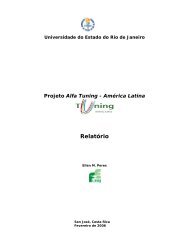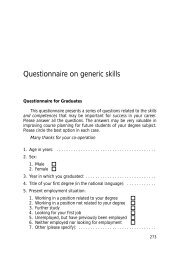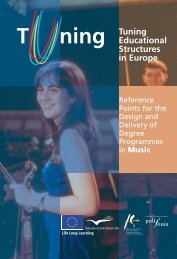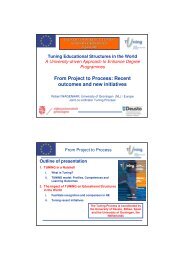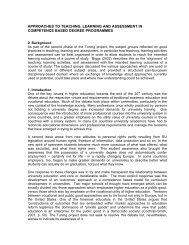student workload, teaching methods and learning ... - ECOMMIS
student workload, teaching methods and learning ... - ECOMMIS
student workload, teaching methods and learning ... - ECOMMIS
You also want an ePaper? Increase the reach of your titles
YUMPU automatically turns print PDFs into web optimized ePapers that Google loves.
An approachI. Module(number of credits / <strong>student</strong> hours)IV. Adjustment ofthe unit either withregard to thenumber of creditsallocated or theeducationalactivitiesII. Planningeducationalactivities /determining<strong>student</strong> timeinvolvedIII. Checking of <strong>workload</strong> by <strong>student</strong>evaluations in terms of real timeinvolvedFour stepsTo realize the overall objective, namely the development of an approach which leads toa truly valid consideration of a <strong>student</strong>’s <strong>workload</strong>, implementation of the following foursteps is recommended.I. Introducing modules/course unitsA choice must be made between the use of a modularized or a non-modularizedsystem. In a non-modularized system each course unit can have a different number ofcredits although the total credits for each academic year will still be 60. In amodularized system the course units/modules have a fixed number of credits, 5 creditsfor example, or a multiple of this number. The use of a modularized system in aninstitution facilitates the use of the same modules by <strong>student</strong>s enrolled in differentprogrammes.II. Estimating <strong>student</strong> <strong>workload</strong>The <strong>workload</strong> of a module/course unit is based on the total amount of <strong>learning</strong> activitiesa <strong>student</strong> is expected to complete in order to achieve the foreseen <strong>learning</strong> outcomes.It is measured in time (in work hours); for example, a module of 5 credits allows foraround 125-150 hours of work of a typical <strong>student</strong>.Educational activities can be defined by considering the following aspects:• Modes of instruction (types of <strong>teaching</strong> <strong>and</strong> <strong>learning</strong> activities): lecture, seminar,research seminar, exercise course, practical, laboratory work, guided personalstudy, tutorial, independent studies, internship, placement or ‘stage’, fieldwork,project work, etc.• types of <strong>learning</strong> activities: attending lectures, performing specific assignments,practising technical or laboratory skills, writing papers, independent <strong>and</strong> privatestudy, reading books <strong>and</strong> papers, <strong>learning</strong> how to give constructive criticism ofthe work of others, chairing meetings, etc.• types of assessment: oral examination, written examination, oral presentation,test,, paper/essay, portfolio, report about an internship, report on fieldwork,continuous assessment, (final) thesis/dissertation, etc.Teachers estimate the time required to complete the activities foreseen for each courseunit / module. The <strong>workload</strong> expressed in time should match the number of credits



